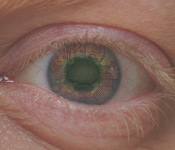
Since he was an undergraduate student, Dr. Paul J. May has been interested in how the brain responds to stimuli. May, an associate professor of anatomy who also holds appointments in ophthalmology and neurology, did his first research on the brain as an undergraduate student at Brown University and began to focus on gaze control while earning his Ph.D. at Duke University.
Gaze control involves coordinating eye and head movement in response to stimuli in the environment that cause us to look more closely at items of interest. May has examined the control of eye movements, the lens, pupil and eyelids over the past 20 years in studies funded by the National Eye Institute. As principal investigator of a third NEI study, “Midbrain Circuitry for Neuronal Control of Gaze,” funded by a four-year grant from the National Institutes of Health, he’s returned to the initial query that sparked his interest in research: How, exactly, does the brain work? This time his emphasis is on the brain circuits coordinating eye and head movement.
A family member with torticollis —an involuntary contracting of neck muscles that results in an unnatural position of the head —has given May’s study a personal motivation.

“It’s as if the system that would normally turn your head to look at something is turned on and won’t turn off,” May says about torticollis, which has no known cure. “This project could allow physicians to make more rational hypotheses about what is happening to patients who have this disease.”
To treat torticollis, scientists first must understand how the relevant parts of the brain are connected, and how they receive and send messages to the rest of the body. “When the output and input mechanisms are definable, it becomes easier to see how the brain goes about solving a problem,” May says.
May describes himself as a connectional neurobiologist—a scientist who studies how different parts of the brain are connected. He began by investigating the superior colliculus, the small bump at the back of the brainstem that controls where gaze is directed.
The decision about where to direct one’s look is organized in the colliculus as a map of activity across its surface. In this “place code,” movement to a specific target in space is coded as activity of neurons at one location within the colliculus. However, the signal from the colliculus doesn’t specify which muscles in the eye or neck should respond; instead, intermediate sites in the brainstem convert the collicular information into signals appropriate muscles can follow. May’s project looks at areas in the brain that receive these “place code” signals from the colliculus and convert them to “muscle code” signals.
The NEI study concentrates on the central midbrain reticular formation, or cMRF, which rests just underneath the colliculus. May and Dr. Susan Warren, associate professor of anatomy and grant co-investigator, are working to identify and track where neurons in the cMRF are going, and are examining whether they receive input from the colliculus.
“This study allows us to determine in detail how signals are coming into the structure (cMRF) and how they are then being sent back out,” May says. “Until we know all the pathways involved in turning the head, we won’t have all the suspects for where the problems that cause torticollis lie.”
May’s current work is not limited to studying midbrain circuitry. He serves as co-investigator on two other studies—one looking at how the brain attends to important visual sensory information and another concentrating on zona incerta, a brain structure whose role is still largely a mystery.
“There are so many structures in the brain, each with a vast amount of cells that carry information to so many different places throughout the body, that there is always something to study,” May says. “That’s what makes neuroanatomy so interesting and fun.”